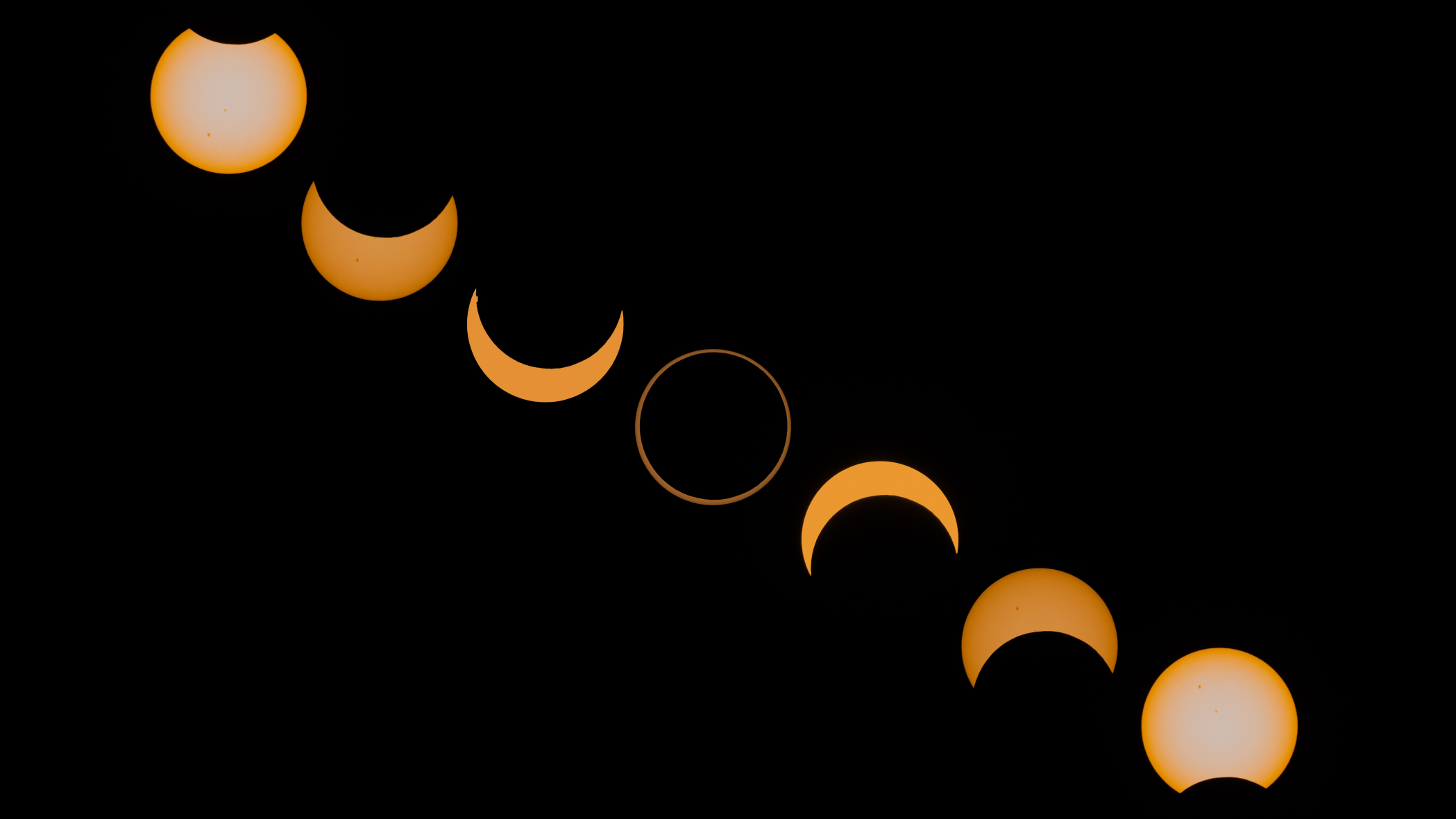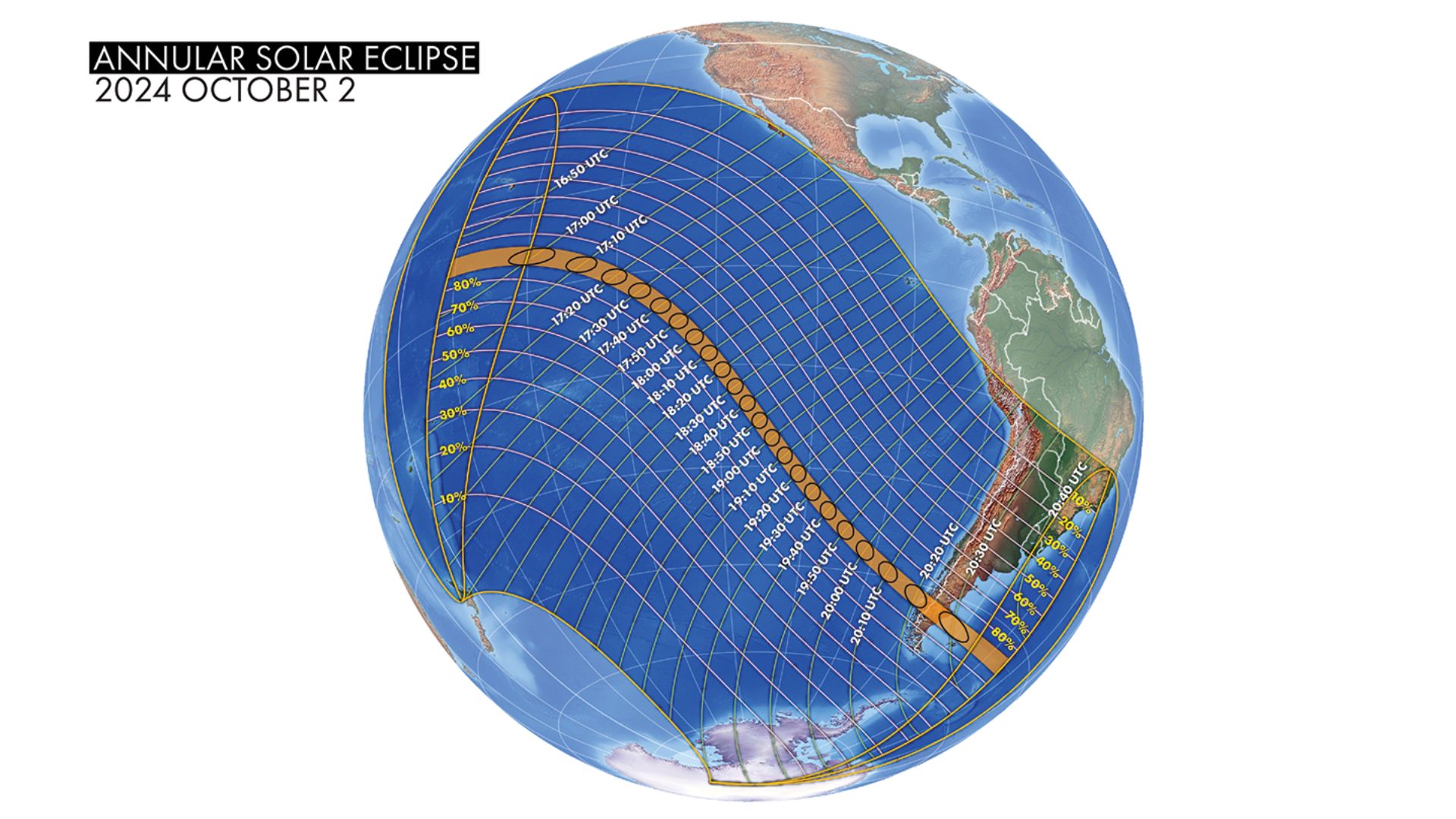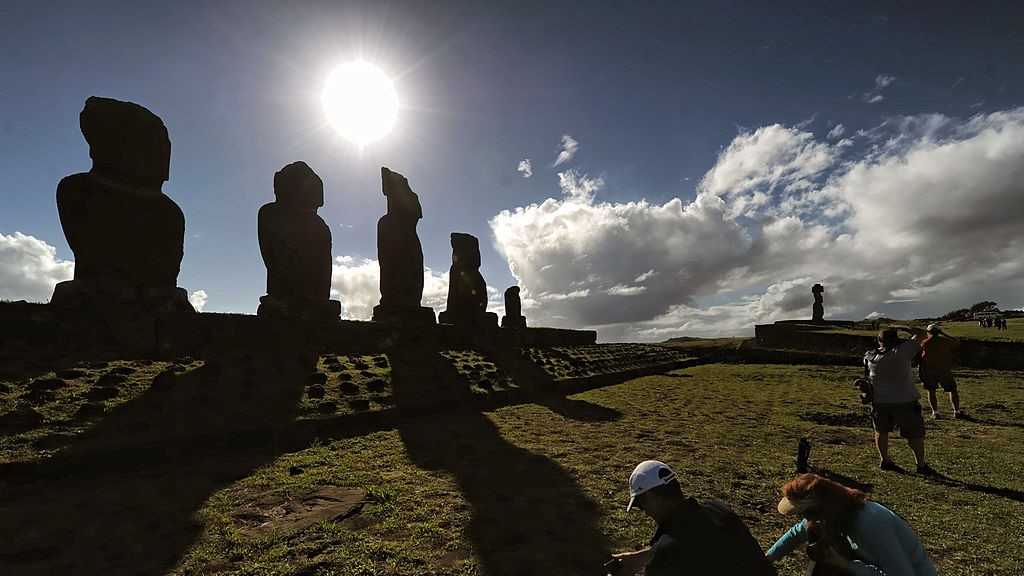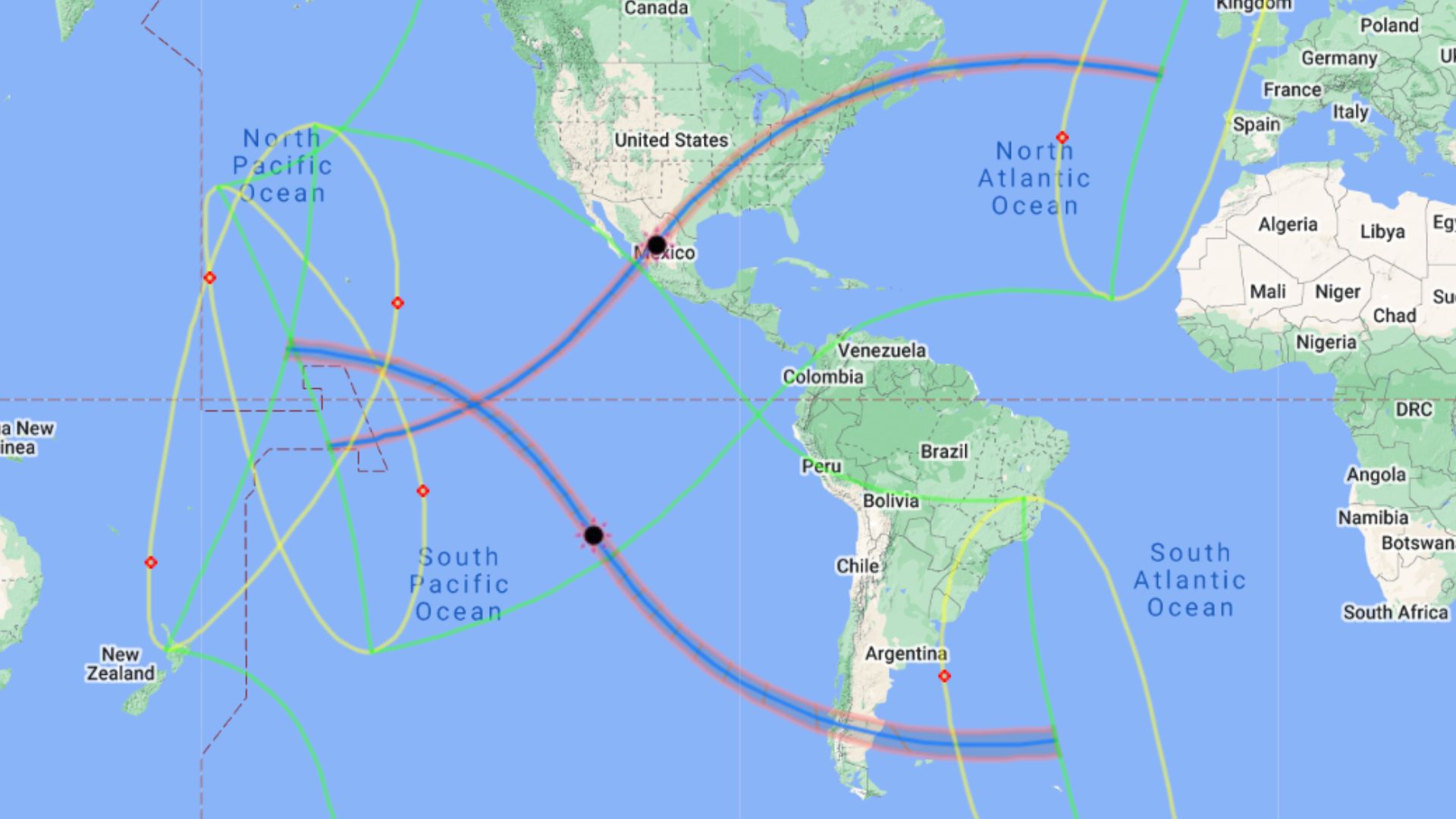
On Oct. 2, 2024, an annular solar eclipse will pass over parts of the Pacific Ocean, southern Chile and southern Argentina.
During an annular solar eclipse, the moon drifts in front of the sun while it's slightly farther from Earth than during a total solar eclipse, so it doesn't completely cover the sun's disk. Instead, it leaves a distinct ring of light around the moon, which is why an annular solar eclipse is also known as a "ring of fire" solar eclipse. At the point of greatest eclipse in the Pacific, the moon will obscure 93% of the sun's center, creating a "ring of fire" visible for 7 minutes and 25 seconds.
You can keep up with all the solar eclipse action with our live blog. We will also stream the eclipse live on Space.com courtesy of TimeandDate.
During an annular solar eclipse, it is NEVER safe to look directly at the sun without solar eclipse glasses designed for solar viewing. Read our guide on how to observe the sun safely.
So, ready to go eclipse chasing? Here's everything you need to know about the annular solar eclipse on Oct. 2, 2024, in Chile and Argentina.
What is an annular solar eclipse?
The Oct. 2 eclipse will be very similar to the annular solar eclipse on Oct. 14, 2023, which was visible across the U.S. Southwest, Central America and South America. All solar eclipses occur when a new moon is positioned precisely between Earth and the sun and casts its shadow on Earth. However, unlike a total solar eclipse, an annular solar eclipse occurs when the moon is slightly farther from Earth. So, even when the disks align from our perspective, the moon's shadow doesn't completely block out the sun's light. Instead, a ring of sunlight is visible around the moon.
Related: What's the difference between a total solar eclipse and an annular solar eclipse?
The eclipse on Oct. 2, 2024, will have an eclipse magnitude of 0.9326, according to EclipseWise.com. That means about 93% of the sun will be blocked by the moon during the eclipse, resulting in an "annulus" (Latin for "ring"). The moon will appear 6.4% smaller than average, according to MoonBlink.
The closer the observer is to the centerline, the more circular the ring of fire will be and the longer it will last. But experienced eclipse chasers often observe from the edge of the path during an annular solar eclipse to see extended views of Baily's beads fizzing around where the limb of the moon appears to touch the sun. They can be visible for several minutes.
Where can I see the eclipse from?

The ring of fire will be visible only within a path of annularity that passes across the Pacific Ocean, southern Chile and southern Argentina.
This area will include the volcanic island of Rapa Nui/Easter Island, an iconic travel destination that's famous for the mysterious stone statues called moai, some of which reach 40 feet (12 meters) tall and weigh 75 tons. The island, which is only 63 square miles (163 square kilometers), is located 2,300 miles (3,700 km) from the Chilean coast, making it the most isolated inhabited landmass on Earth. Remarkably, it will be the second time a central solar eclipse has been visible from this tiny Pacific island in recent decades, with a total solar eclipse glimpsed there on July 11, 2010. The next total and annular eclipses there will be in 2324 and 2345, respectively.
A good option would be to position yourself slightly south of a moai at multiple sites to get a view of the ring of fire just above one of the statues, according to the Atlas of Solar Eclipses — 2020 to 2045. Iconic locations will include the platform at Ahu Tongariki, where 15 moai are positioned on a 200-foot-long (60 m) ceremonial platform and nearby Rano Raraku.
October's ring of fire will also be visible from southern Patagonia in Chile and Argentina. The path will be between 165 to 206 miles (265 to 331 km) wide.
Read more: Where can I see the annular solar eclipse on Oct. 2, 2024?
We will also be livestreaming the entire annular solar eclipse live here on Space.com, more details will be released closer to the time.
Best locations to see the eclipse

You can read more about the 16 best places to see the annular 'ring of fire' solar eclipse 2024 in our comprehensive guide.
Here are some places eclipse chasers will gather for this annular solar eclipse:
- Rapa Nui/Easter Island, Chile (5 minutes, 38 seconds to 6 minutes, 12 seconds of annularity starting at 14:03 EAST, 67 degrees above North)
- Cochrane, Chile (5 minutes, 40 seconds of annularity starting at 17:21 CLST, 26 degrees above NNW)
- Perito Moreno National Park, Argentina (6 minutes, 17 seconds of annularity starting at 17:21 ART, 25 degrees above NNW)
- Puerto Deseado, Argentina (3 minutes, 22 seconds of annularity starting at 17:27 ART, 20 degrees above NNW)
- Puerto San Julian, Argentina (5 minutes, 12 seconds of annularity starting at 17:24 ART, 21 degrees above NNW)
Organized eclipse-viewing tours include Sky & Telescope, TravelQuest and AstroTrails. All are experienced eclipse tour operators that are headed to Rapa Nui/Easter Island.
What will the weather be like?

It's always best to travel somewhere you want to visit regardless of a solar eclipse. That certainly applies to the Oct. 2 event, because the prospects of a completely clear sky are relatively low. The chances of clouds that day are 75% for Rapa Nui/Easter Island, 90% for Perito Moreno National Park, and 65% to 70% for locations on Argentina's Atlantic coast, according to Time and Date.
On Rapa Nui/Easter Island, the cooling of the land could cause convective clouds to dissipate, according to Eclipsophile, with the south coast statistically slightly favored. The chances of seeing the ring of fire are smallest on Chile's Pacific Coast and highest on Argentina's Atlantic coast. The latter has the least interesting scenery of anywhere in the path, but the eclipse will arguably be a more dramatic sight because it will occur much lower in the sky.
Why is the Oct. 2, 2024, annular solar eclipse special?

The Oct. 2, 2024, annular solar eclipse is special for three very different reasons. First, it follows the Great North American Eclipse of April 8 — so interest in solar eclipses should be high, and many eclipse chasers will travel to see it.
Second, it's a long eclipse, with the ring of fire lasting up to 7 minutes, 25 seconds. That's much longer than the 4 minutes, 52 seconds possible in the U.S. during the last annular solar eclipse on Oct. 14, 2023.
Third, the best place to view this event is a truly iconic destination: Rapa Nui, also called Easter Island.
Where to see the partial solar eclipse on Oct. 2
Although a ring-of-fire eclipse will be visible only from the aforementioned areas of Chile and Argentina, other areas will experience a partial solar eclipse on Oct. 2. These areas include parts of the Pacific Ocean and the southern half of South America. Here's what percentage of eclipse will be seen from major cities and destinations in the partial-eclipse zone:
- Galapagos Islands (1%)
- La Paz, Bolivia (1%)
- Rio de Janeiro, Brazil (9%)
- São Paulo, Brazil (10%)
- Buenos Aires, Argentina (42%)
- Montevideo, Uruguay (42%)
- Santiago, Chile (44%)
- Villarrica, Chile (63%)
- El Calafate, Argentina (83%)
- Falkland Islands (84%)
- South Georgia Island (76%)
- Punta Arenas, Chile (75%)
- Ushuaia, Argentina (72%)
- Elephant Island (56%)
- Port Lockroy, Antarctica (44%)
After October 2024, when is the next annular solar eclipse?
Here are the dates and locations for some upcoming annular solar eclipses:
- Feb. 17, 2026: Antarctica
- Feb. 6, 2027: Chile, Argentina, Uruguay, Côte d'Ivoire, Ghana, Togo, Benin and Nigeria
- Jan. 26, 2028: Galapagos Islands, Ecuador, Brazil, French Guiana, Portugal, Morocco and Spain
- June 1, 2030: Algeria, Tunisia, Greece, Turkey, Russia, Kazakhstan, China and Japan
Additional resources
Want to look further ahead? You can find a concise summary of solar eclipses out to 2030 on NASA's eclipse website. Read more about solar and lunar eclipses on EclipseWise.com, a website dedicated to predictions of eclipses. See beautiful maps on eclipse cartographer Michael Zeiler's GreatAmericanEclipse.com and interactive Google Maps on Xavier Jubier's eclipse website. You can find climate and weather predictions by meteorologist Jay Anderson on eclipsophile.com.
Bibliography
Anderson, J. (February 2024). Annular Solar Eclipse
2024 October 2. Retrieved March 1, 2024 from https://eclipsophile.com/annular-solar-eclipse-october-2-2024/
Bakich, M. and Zeiler, M. (2022). Atlas Of Solar Eclipses 2020-2045.
https://www.greatamericaneclipse.com/books/atlas-of-solar-eclipses-2020-to-2045
Espenak, F. Solar Eclipse Prime Page: Annular Solar Eclipse of 2024 October 2. Retrieved March 1, 2024 from: https://eclipsewise.com/solar/SEprime/2001-2100/SE2024Oct02Aprime.html
Jubier, X. (n.d.). Solar eclipses: Interactive Google Maps. Retrieved March 1, 2024 from http://xjubier.free.fr/en/site_pages/SolarEclipsesGoogleMaps.html
Time and Date. (n.d.). October 2 2024 Annular Solar Eclipse. Retrieved March 1, 2024 from https://www.timeanddate.com/eclipse/solar/2024-october-2







